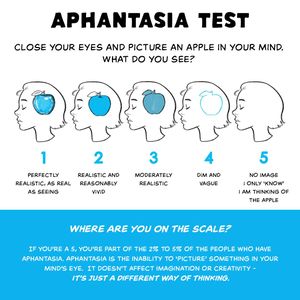Aphantasia: Difference between revisions
From BurnZero
(Created page with "alt=Aphantasia|thumb|'''Figure 1'''. A quick and easy test to see if you have aphantasia. '''Aphantasia is a condition characterized by the inability to generate on-demand visual mental images.''' === Occurence === People often don't realize they have it until they try psychedelics, and it's not a disability or medical condition. Around 0.8% of the population was unable to form visual mental images, and 3.9% of the population are either unable t...") |
mNo edit summary |
||
| (One intermediate revision by the same user not shown) | |||
| Line 1: | Line 1: | ||
[[File:Aphantasia.jpg|alt=Aphantasia|thumb|'''Figure 1'''. A quick and easy test to see if you have aphantasia.]] | [[File:Aphantasia.jpg|alt=Aphantasia|thumb|'''Figure 1'''. A quick and easy test to see if you have aphantasia.]] | ||
'''Aphantasia is a condition characterized by the inability to generate on-demand visual mental images.''' | '''Aphantasia is a condition characterized by the inability to generate on-demand visual mental images.''' First described by Francis Galton in 1880, it remained unstudied until 2015 when Professor Adam Zeman's team coined the term. | ||
=== | === Prevelenace === | ||
People often don't realize they | People often don't realize they are aphantasic until they try [[psychedelics]] where they are supposed to see imagery which is often absent. One study estimates taht around 0.8% of the population is unable to form visual mental images, and 3.9% of the population are either unable to form mental images or have dim or vague mental imagery<ref>'''The prevalence of aphantasia (imagery weakness) in the general population'''. Journal of Consciousness and Cognition. 97: 103243. Dance CJ, Ipser A, Simner J (January 2022). doi:10.1016/j.concog.2021.103243. <nowiki>PMID 34872033</nowiki>. S2CID 244837117.</ref>. | ||
'''References''' | '''References''' | ||
Latest revision as of 03:45, 30 December 2023
Aphantasia is a condition characterized by the inability to generate on-demand visual mental images. First described by Francis Galton in 1880, it remained unstudied until 2015 when Professor Adam Zeman's team coined the term.
Prevelenace
People often don't realize they are aphantasic until they try psychedelics where they are supposed to see imagery which is often absent. One study estimates taht around 0.8% of the population is unable to form visual mental images, and 3.9% of the population are either unable to form mental images or have dim or vague mental imagery[1].
References
- ↑ The prevalence of aphantasia (imagery weakness) in the general population. Journal of Consciousness and Cognition. 97: 103243. Dance CJ, Ipser A, Simner J (January 2022). doi:10.1016/j.concog.2021.103243. PMID 34872033. S2CID 244837117.
